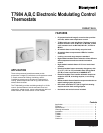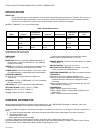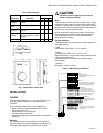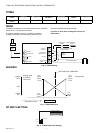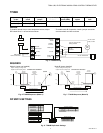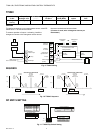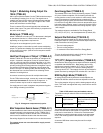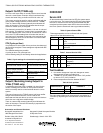
T7984 A,B,C ELECTRONIC MODULATING CONTROL THERMOSTATS
Output 1, Modulating Analog Output 2 to
10Vdc (T7984 All)
Main output of the thermostat. On the T7984 series that output
is modulating PI analog (2 to 10 Vdc). That signal uses a
variable Vdc signal for the control of analog damper actuator
and analog valve actuator. This type of output on the T7984
series uses a half wave rectifier bridge.
There is a status LED mounted internally that indicates the
action of the output. The green LED intensity is proportional to
the action of the output.
Mode Input (T7984B only)
Model T7984B has a mode input. This thermostat is designed
to operate and function in 2 distinct mode of operation
depending on the application requirements.
This input is not a changeover input for output 1.
Installing a jumper on the mode input will reverse modulating
output 1 to operate as a heating only output & the on/off output
2 as a cooling only output. (See the control sequence section
for each thermostat.)
Heat/Cool Changover of Output 1 (T7984A & C)
Models T7984A & C all have the possibility of changeover for
output 1. Automatic changeover is used on systems were a
valve or a VAV unit may have cold and hot water or air in the
same system depending on the season. Basically output 1 is
primarily cooling (Direct Acting) when the changeover input is
not activated. Activating the changeover input reverses the
function of output 1 to heating mode (Reverse Acting) so that
the thermostat can use the end device as a heating device
instead of a cooling device.
A common contact may be used for multiple thermostats.
For the T7984 series a single, common dry contact or 1 supply
sensor per thermostat can be used for changeover. A
common contact may be used for multiple thermostats.
If a supply sensor is used, changeover temperature trip point
from cooling to heating is as follows:
Output 1
Heating mode
Output 1
Cooling mode
M24003
(25°C) (26°C)
Supply
75°F 78°F
Temp
Fig. 12. Changeover temperature trip point.
Main Temperature Remote Sensor (T7984A, B, C)
All thermostats have their internal sensing device (Thermistor)
mounted internally in the thermostat. On the T7984A, B & C
models, it is possible to install a remote room or remote duct
return sensor at a different location than the thermostat.
See wiring diagram for each model on how to wire the sensor.
The remote sensor are not to be used for supply control
applications.
Zero Energy Band (T7984B & C)
Thermostats which have cooling and heating outputs (T7984B
& C) have 2 distinct setpoints, one for heating the other for
cooling (see the control curves section for each model). When
the room temperature is between these to setpoints both
heating and cooling outputs are off and the room temperature
is in the Zero Energy Band. When the room temperature drops
below the heating setpoint, output 2 output will energize. When
the room temperature rises above the cooling setpoint, output
1 will energize.
Two settings values are available for Zero Energy Band:
3°F(1.5°C) or 5°F(3°C) , can be adjusted with dip switch (S2).
Setpoint Dial Definition (T7984 B & C)
Because these thermostats have 2 distinct setpoints; one for
heating the other for cooling, the thermostat setpoint dial knob
need to be defined as being either:
• The true heating setpoint
• The true cooling setpoint
• Or centered in the middle of the Zero Energy Band.
This can be adjusted with dip switch (S3 & S4). (See the
control curves section for each model.)
75°F (25°C) Setpoint Limitation (T7984B & C)
Models with a reheat output have setpoint limitation capability
compatible with ASHRAE 90.1. Both heating and cooling
setpoints are internally limited to 75°F (24°C). The cooling
setpoint cannot go below 75°F while the heating setpoint
cannot go above 75°F. This setpoint limit can be overridden for
system checkout by setting the DIP switches S3=1 and S4=1.
NSB Day/Night Mode (T7984B & C)
An energy saving mode by which the actual setpoints are
modified to different value than the ones adjusted on the dial.
The cooling setpoint will go up and the heating setpoint will go
down. This mode is energized with a dry contact from a remote
time clock.
Table 4. DIP switch setup and setback values
Two different setup & setback value can be adjusted with a
DIP switch.
S5 = 1 10°F (6°C) heating 20°F (12°C) cooling setpoint
setpoint setback setup (equivalent to cooling
shut down)
S5 = 0 5°F (3°C) heating 5°F (3°C) cooling setpoint
setpoint setback setup
The system LED on the thermostat cover on these models will
flash to indicate that the thermostat is in night mode. The night
mode can be overridden for 2.5 hours for each thermostat
individually by pressing the button switch on the thermostat
cover. This will bring back the thermostat to the day mode
setpoints.
A common NSB timer contact may be used for multiple
thermostats.
7 95C-10815–2



